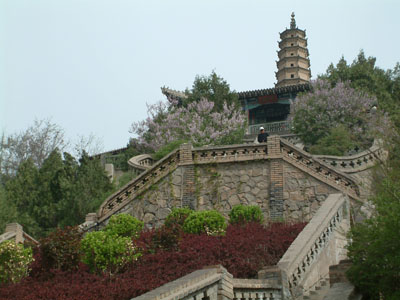Living in Lanzhou
| Located in the east of Gansu Province, Lanzhou, the capital of Gansu Province, is in the geometric center of the geographical location of China. Covering an area of 13,271 square kilometers with a population of 3.05 million, Lanzhou is the political, economic, cultural and commercial and trade center of the province. |
 |
Transport
Lanzhou enjoys an easy traffic. Its Zhongchuan Airport operates more than 20 air-routes to main cities in the country and running through the city are the 6 national highways, such as Nos. 312 and 109 and Lanzhou is also a hinge of 4 optical cable main lines and 4 railways: Longhai, Lanxin (Lanzhou-Urumqi), Lanqing (Lanzhou-Xining-Golmud) and Baolan (Baotou-Lanzhou). In addition, there are also tourists trains from Lanzhou to Xi’an, Xining, Yinchuan, Jiayuguan, Tianshui, Zhangye and Pingliang and other places.
Climate
The average altitude of Lanzhou is 1520m. In Lanzhou, winters are not extremely cold and summers are not severely hot. In midsummer the average temperature is only 22.6℃.
Local snacks
Created in about 1875, Lanzhou beef noodle enjoys a wide popularity in China and is also the favorite of local people. It is made of ordinary flour mixed with a little specially-made plant ash.
Tian Peizi-sweet fermented wheat is another snack in Lanzhou. Cold boiled water, sugar and fermented wheat are mixed together to get this cold refreshing summertime snack. In Lanzhou you can also enjoy Shish Kebab, Red Pea gruel and hot Dongguo pear etc.
Places of interest
Lanzhou abounds with melon and fruit, hence renowned as a “City of Melon and Fruit”. Lanzhou is also the only city in China through which runs the Yellow River and the city is rich in cultural relics and varied and colorful scenic attractions. Along the green corridor by the riverside visitors to Lanzhou may find chances to enjoy the Yellow River, Waterwheel Park, Provincial Museum, Yellow River Mother Sculpture and also the White Dagoda Hill, Zhongshan Iron Bridge, the first iron bridge over the Yellow River and Five-spring Hill, etc. To the suburban areas there are such attractions as the Xinglong Mountain, Local Official Yamen known as Lu Tusi Yamen and Tulugou scenic spot as well. Visitors can also go to other places for a visit via Lanzhou, such as Bingling Grotto Temple in Yongjing County, Labrang Lamasery in Xiahe and Maijishan (Wheat Stack) Mountain Grottos in Tianshui and so on and so froth.
Statue of the Yellow River
 |
The Yellow River is referred to as the Mother of Chinese nation. Lanzhou is the only provincial capital city that the Yellow River runs through. As a tribute to their mother river the people of Lanzhou erected this bridge. It has become a photographic must for tourists from home and abroad. The statue was designed by Ms He E of Gansu Province. It is made of granite, with length of 6 m, width of 2.2m and height of 2.6m. The total weight of it reaches over 40 tons. |
White Dagoba and its special features
Lying along the north of the Yellow River, the White Dagoba Hill is located in the center of the City of Lanzhou with the name of the hill derived from the White Dagoba atop the hill. Rising over 1700 meters above sea level, the hill features an undulating range, suggesting a magnificence of “Embracing the Gold City”.
To view the north on the south bank of the Yellow River, the iron bridge over the river, the group of buildings in the White Dagoba Hill Park and the White Dagoba Temple atop the hill form an agglomerated integrity that jumps into your eyes all at once, hence known as a “distant view over the river and bridge”. On crossing the iron-bridge, you are faced with a cluster of buildings seated on the three tiers of the White Dagoba Hill with green trees setting off the vermilion pillars and flying eaves. The stone-steps and walls, kiosks and pavilions and terraces that are linked up into one with a twisting covered corridor escalating gradually upwards, forming a compact a structure and contrasts of terraces in between, a unique style in the Chinese art of architecture in China’s ancient times. Up above the 3rd terrace of the White Dagoba Hill is the main peak of the hill with a steep terrain, built on which are the archway known as “Phoenix Forest & Incense Fragrance”, the Arhats Hall and the Sanguan Hall. Besides, on top of the hill are the Three Gods Hall and the Guesthouse of Hailing the Rising Sun, where visitors can stay to view the sunrise and the splendor of the Yellow River right down underfoot.
Gansu Provincial Museum
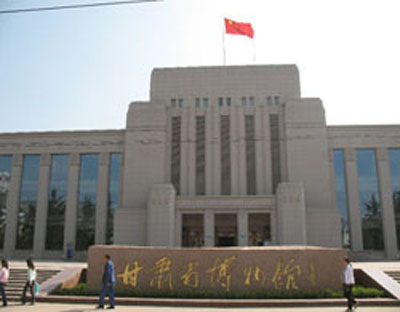 |
Gansu Provincial Museum, located opposite the Friendship Hotel, in Qilihe district is the largest Museum with a comprehensive collection of museum pieces. Built in 1956 it covers a total floor space of 18,000 square meters. The museum consists of 13 exhibition halls, a hall for lectures and 12 rooms for s short rest. Kept in the museum is a great collection of relics, numbering 75,000 pieces of different ages, but most of them are the colorful pottery-pieces and precious art-pieces from various grottoes. |
Five Spring Hill Park
| Located at the northern foot of the hill in the south of Lanzhou, the Five Spring Hill Park is a famous scenic attraction in the city with its name derived from the five springs bubbling up in the park lying at the foothill. A saying has it that during the reign of Emperor Wu (140~87 BC) of the Han Dynasty when General Huo Qubing was on his expedition against the Huns he once stationed his troops at the foothill. The moment when soldiers felt very thirsty and tired he pointed at the ground with his horsewhip and all at once out gushed from underneath five springs, hence the derivation of the names later on Sweet Spring, Scooping Moon, Fumbling for Son, Deceptive and Beneficial for the five springs here. |
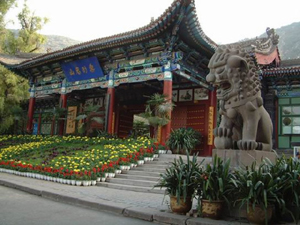 |
Water Wheel Garden Park
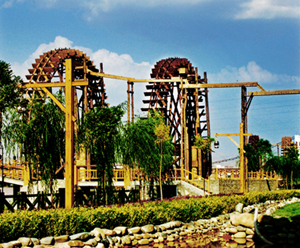 |
Waterwheel was used to draw water from the Yellow River for irrigation in ancient times. It was firstly invented in Eastern Han Dynasty (25-220AD) and was introduced into Lanzhou in 1566AD. |
Xinglong Mountain
Situated five kilometers to the southwest of Yuzhong County seat, about 60 kilometers away from the city of Lanzhou the Xinglong Mountain, named “Clouds Perching Mountain” has been known as a Taoist seclusion in as early as the Western Zhou Period in Chinese History.
Consisting of two peaks the Xinglong Mountain is a national forest park, a nearest one away from the city of Lanzhou. Towering 2,400 meters high the eastern peak is called “Xinglong” and the western one the “Qiyun” which stands 2,500 meters above sea level. With the Xinglong Gorge in between it is spanned up by a bridge named “Dragon and Cloud Bridge”. Now on the Qiyun Peak there are several Taoist buildings while on the Xinglong Peak one will see some Buddhist buildings and scenic attraction. |
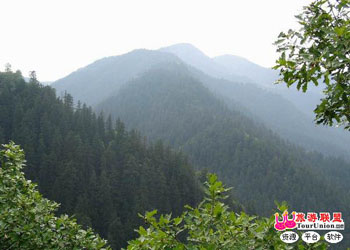 |
Zhongshan Briage
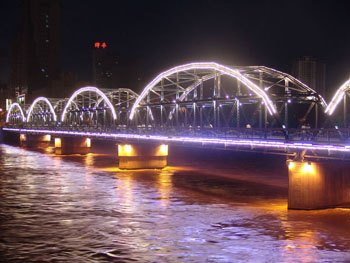 |
Zhongshan Bridge is referred to as “the First Bridge on the Yellow River”. This iron bridge was built in 1907, stretching 240m and has witnessed all the changes along the Yellow River in the last century. In 1954, 5 steel archways were added for reinforcing the bridge. Now it has already been 100 years old and retired, only allowing walking and bicycling. |
Cited from:
Gao Yafang & Qin Binfeng (2008). The Tour Guides’ Speech Collection About Gansu [M]. Beijing: China Travel and Tourism Press
Han Rongliang & Han Zhiyu (2006). Guide to Gansu [M].Beijing: China Travel and Tourism Press
|


